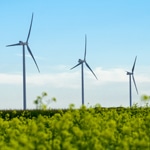When John A. Giunco joined New Jersey law firm Giordano, Halleran & Ciesla, he knew he’d be practicing real estate. It wasn’t until recently, however, that he began specializing in the development of solar and wind generation facilities. Giunco tells gb&d how such projects gets under way and what legal experts bring to it.
From Landfill to Solar Plant
When developers wanted to convert two New Jersey landfills into solar generation facilities, they called Giordano, Halleran & Ciesla. There were problems to solve: The facility was built on a pile of waste, so soil compaction had to be addressed. So did the potential for contamination. Three levels of government were involved, with approvals necessary from New Jersey’s Department of Environmental Protection because of the impact on the environment, the county because of the impact on roads and storm water, and the municipality because of the land use. All in all, however, it was a success. “The land-which was just sitting there is now being reused to generate electricity-18 megawatts in one case, 8 megawatts in the other,” says Giunco.
How does an alternative energy generation project get under way?
John A. Giunco: A developer anticipates it can profit from the development of a site and sale of power to a public utility or private entity. The first question it has to ask is how the power will get into the grid system, and to answer that, our clients generally look for wires that are capable of receiving power and transmitting it into the grid. Once they locate the power lines, they do feasibility studies of the site to determine if it’s economically viable, if it can be engineered, and if it can obtain the necessary permits.
What happens if the project is feasible?
Giunco: The client has to obtain the rights to use the land through lease or purchase. It also has to get approvals to build the project from the state, county, municipality, and the consortium called PJM [for Pennsylvania, Jersey, Maryland Power Pool.] It then enters contracts for all activities associated with development-power sharing with utilities, construction, etc.
What’s your role in the process?
Giunco: We negotiate contracts, obtain permits, that sort of thing.
How many of these projects do you do?
Giunco: Over the past 18 months, we’ve been involved in the development of solar generation facilities producing around 350 megawatts of power.
How is the industry changing?
Giunco: We pursued renewable energy projects because there was a decline in traditional residential and commercial development activity. Now, proposed state legislation would reduce alternative energy incentives. As such, I think it will limit development of these projects.
What are your thoughts on those limitations?
Giunco: A lot of people still don’t understand alternative power. Recently, the Pinelands Preservation Group opposed a solar development on a landfill because there were no local benefits. But the local impact has to be weighed against the overall benefit to the state and country because we all use electricity that’s generated in other states.

